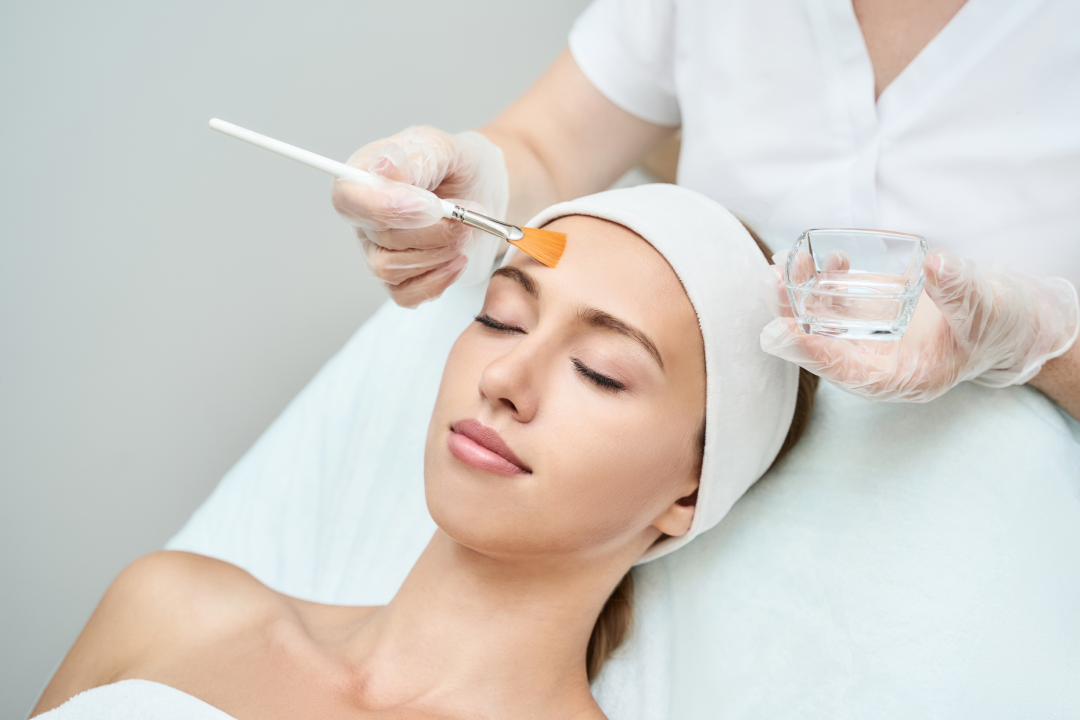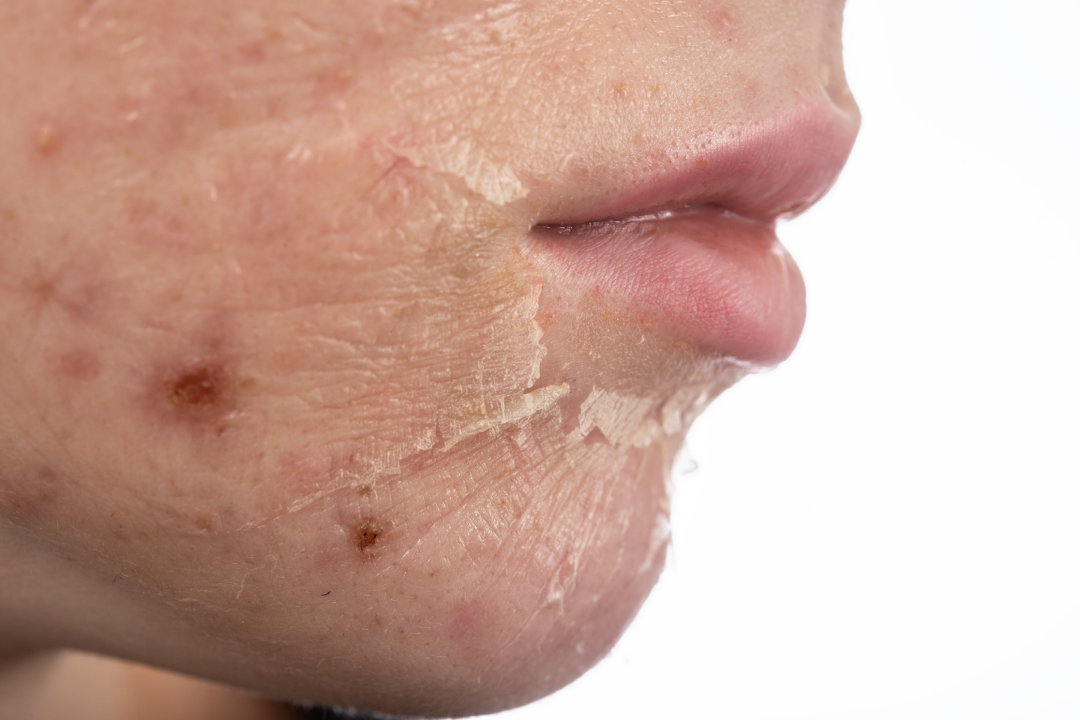Achieving and maintaining flawless skin is a goal many aspire to. Chemical peels have emerged as a potent solution, offering transformative results for various skin concerns. However, the journey to radiant skin doesn’t end with the procedure; proper post-peel care is paramount to preserve and enhance the benefits of the treatment.
Understanding the significance of aftercare can make the difference between a temporary glow and lasting rejuvenation. In this comprehensive guide, we’ll delve into what chemical peels are, the specific types offered at Metropolis Dermatology, and, most importantly, the essential steps to care for your skin post-treatment.
What Are Chemical Peels?
Chemical peels are cosmetic procedures that involve applying a specialized chemical solution to the skin, causing controlled exfoliation. This process removes damaged outer layers, revealing smoother, more youthful skin beneath. They are effective in addressing a range of skin issues, including hyperpigmentation, fine lines, wrinkles, and uneven texture.
The primary benefits of chemical peels include:
- Hyperpigmentation Treatment: Reducing dark spots and evening out skin tone.
- Wrinkle Reduction: Smoothing fine lines and wrinkles for a more youthful appearance.
- Acne Management: Clearing clogged pores and reducing acne breakouts.
- Improved Skin Texture: Enhancing overall skin smoothness and vitality.
At Metropolis Dermatology, we offer a variety of chemical peels tailored to meet diverse skin needs and concerns.
Our Range of Chemical Peels
Understanding the specific peels available can help you choose the most suitable treatment for your skin goals. Here’s an overview of the chemical peels we offer:
- Acne VI Peel. Designed specifically for individuals struggling with active acne, the Acne VI Peel targets acne-causing bacteria and reduces inflammation. This peel not only addresses current breakouts but also helps prevent future occurrences, promoting clearer and healthier skin.
- Acne Plus Peel. The Acne Plus Peel combines potent ingredients to treat both active acne and the scars it leaves behind. By accelerating skin turnover and promoting healing, this peel diminishes the appearance of acne scars, leading to a smoother complexion.
- Toning + Pigment Peel. For those dealing with uneven skin tone and pigmentation issues, the Toning + Pigment Peel is an ideal choice. This peel works to brighten the skin and fade hyperpigmented areas, resulting in a more balanced and radiant complexion.
- VI Body Peel. The VI Body Peel extends the benefits of chemical peels beyond the face, addressing skin imperfections on the body such as sun damage, uneven texture, and pigmentation. It’s an excellent option for those seeking comprehensive skin rejuvenation.
- Glycolic Peel 30%. Utilizing glycolic acid, a powerful alpha-hydroxy acid (AHA), the Glycolic Peel 30% effectively exfoliates the skin, promoting cell renewal and improving texture. It’s particularly beneficial for brightening the skin and preventing blemishes and breakouts. Notably, this peel is safe for use during pregnancy.
- Lactic Peel 20%. The Lactic Peel 20% employs lactic acid to gently exfoliate and hydrate the skin. It’s suitable for individuals with sensitive skin and works to repair damage, providing a refreshed and rejuvenated appearance.
- TCA Lightening Peel 10%. Trichloroacetic acid (TCA) is the active component in the TCA Lightening Peel 10%. This peel addresses skin texture irregularities and uneven tone, making it a versatile option for overall skin enhancement.

The Importance of Post-Peel Care
While chemical peels can yield remarkable improvements, the aftercare regimen plays a crucial role in determining the longevity and quality of the results. Proper post-peel care ensures optimal healing, minimizes potential complications, and helps maintain the newfound radiance of your skin.
Key reasons why post-peel care is essential:
- Protecting Vulnerable Skin: Post-peel skin is more sensitive and susceptible to environmental factors.
- Enhancing Results: Appropriate care can amplify the benefits of the peel.
- Preventing Complications: Diligent aftercare reduces the risk of infections and adverse reactions.
Essential Aftercare Tips for Optimal Results
To maximize the benefits of your chemical peel and safeguard your skin’s health, adhere to the following aftercare guidelines:
1. Gentle Cleansing
In the days following your peel, your skin will be delicate. Use cool water and a mild, soap-free cleanser to wash your face. Avoid using washcloths, sponges, or any abrasive tools; instead, cleanse with your fingertips to prevent irritation. Pat your skin dry gently with a soft towel.
2. Consistent Moisturization
Keeping your skin hydrated is vital to facilitate healing and reduce discomfort. Opt for a non-comedogenic, fragrance-free moisturizer to prevent clogged pores and irritation. Apply it generously and as often as needed to maintain skin comfort.
3. Sun Protection
After a chemical peel, your skin becomes more sensitive to ultraviolet (UV) radiation. It’s imperative to apply a broad-spectrum sunscreen with an SPF of at least 30 daily, even on cloudy days or when indoors near windows.
Reapply every two hours when exposed to the sun. Additionally, minimize direct sun exposure by wearing protective clothing and seeking shade whenever possible.
4. Avoiding Heat and Perspiration
Exposing your skin to excessive heat can lead to inflammation and prolong the healing process. For at least a week post-peel, avoid activities that generate heat and sweating, such as hot showers, saunas, steam rooms, and intense workouts. Sweat can also introduce bacteria to your sensitive skin, increasing the risk of irritation or breakouts.
Tip: If you need to exercise, opt for light activities, such as walking, instead of high-intensity workouts that cause excessive sweating.
5. Avoid Picking or Peeling the Skin
One of the most critical aspects of post-peel care is letting your skin shed naturally. As your skin heals, you may notice flaking or mild peeling—this is a normal part of the process. However, resist the urge to pick or peel the skin manually, as doing so can lead to:
- Scarring or discoloration
- Extended healing time
- Increased risk of infection
Tip: Keep your skin well-moisturized to minimize excessive peeling and allow your body’s natural healing process to work effectively.
6. Use Gentle, Hydrating Skincare Products
Your post-peel skincare routine should focus on soothing, hydrating, and protecting the skin. Choose products that are free of harsh chemicals, alcohol, or strong active ingredients like retinol, glycolic acid, and salicylic acid, which can be too aggressive on freshly treated skin.
- Use: Fragrance-free hydrating serums with ingredients like hyaluronic acid to restore moisture.
- Avoid: Exfoliants, scrubs, or acne treatments until your skin has fully healed.
Tip: Consult with your provider at Metropolis Dermatology to select medical-grade skincare products that complement your treatment and enhance your results.
7. Stay Hydrated and Maintain a Healthy Diet
What you put into your body is just as important as what you apply to your skin. Hydration and proper nutrition play a key role in promoting skin healing and prolonging the benefits of your chemical peel.
- Drink plenty of water to keep your skin plump and hydrated.
- Eat antioxidant-rich foods such as berries, leafy greens, and nuts to promote collagen production and skin repair.
- Avoid processed foods and excessive sugar, which can contribute to inflammation and breakouts.
Tip: Herbal teas rich in chamomile or green tea can help soothe inflammation and promote skin renewal.
8. Schedule Follow-Up Treatments for Long-Term Results
While a single chemical peel can significantly improve skin texture and tone, most patients achieve optimal, long-lasting results through a series of treatments. Depending on your skin type and concerns, your provider may recommend a customized treatment plan with multiple sessions spaced 4 to 6 weeks apart.
- Regular peels help reduce fine lines, wrinkles, and hyperpigmentation over time.
- Different peel strengths can be adjusted for progressive improvements without over-exfoliating the skin.
- Pairing peels with other treatments (like microneedling or laser therapy) can amplify anti-aging and skin-brightening effects.
Tip: Speak with your dermatologist at Metropolis Dermatology about a personalized skincare and treatment plan that aligns with your aesthetic goals.

Why Post-Chemical Peel Care Matters
Taking proper care of your skin after a chemical peel is just as important as the treatment itself. The more attention you give to post-care, the better and longer-lasting your results will be. By following these aftercare tips, you can:
- Enhance the benefits of your chemical peel
- Reduce irritation and discomfort
- Prevent unwanted side effects like hyperpigmentation
- Extend the longevity of your results
At Metropolis Dermatology in Los Angeles, San Jose, Pasadena, LA’s Westside (Brentwood), and Costa Mesa, CA, we’re committed to helping you achieve your best skin through professional treatments and expert aftercare guidance.
Whether you’re looking for a hyperpigmentation treatment, fine line and wrinkle reduction, or a lactic acid peel, we tailor our services to your skin’s unique needs.
Discover the power of chemical peels and elevate your skincare routine—schedule a consultation today with us and experience your healthiest, most radiant skin yet!

